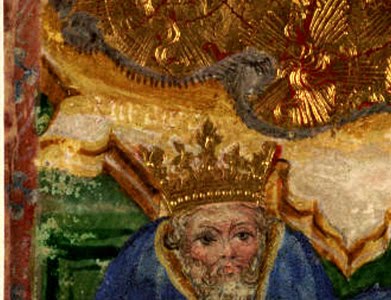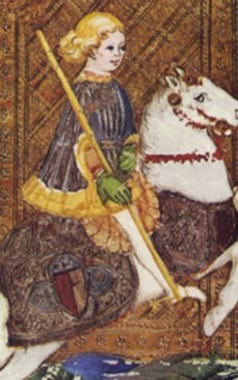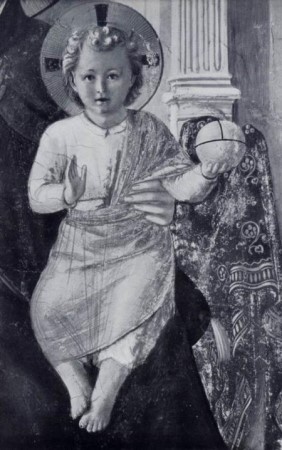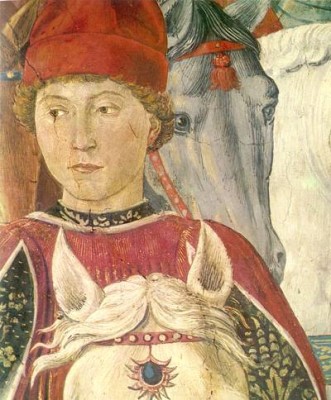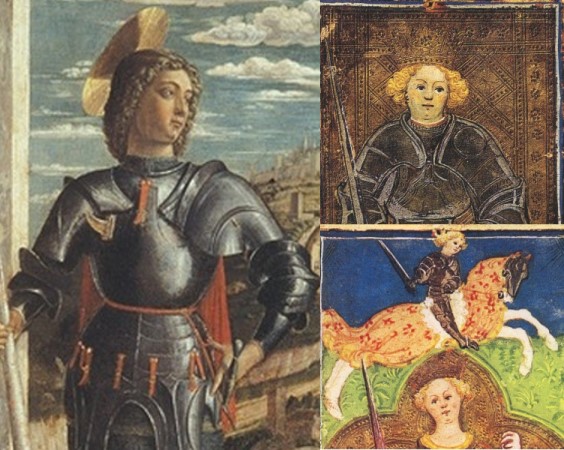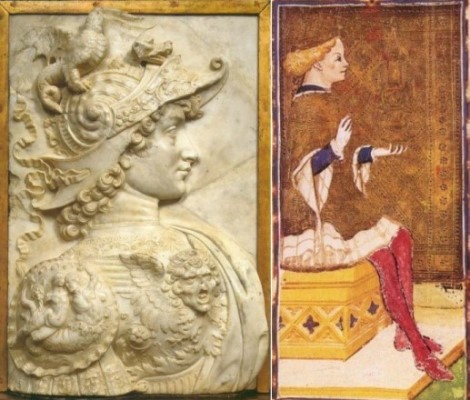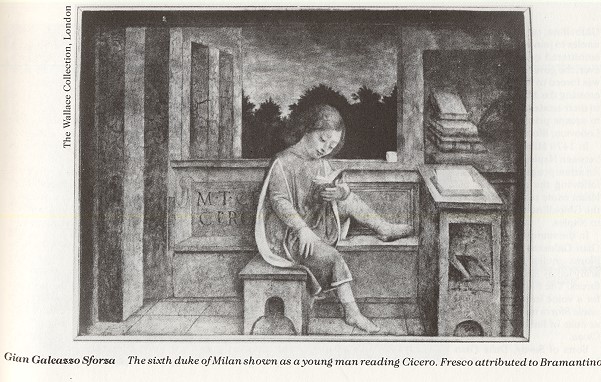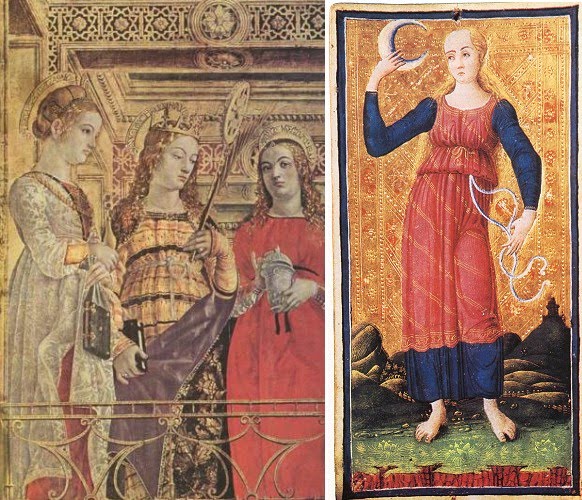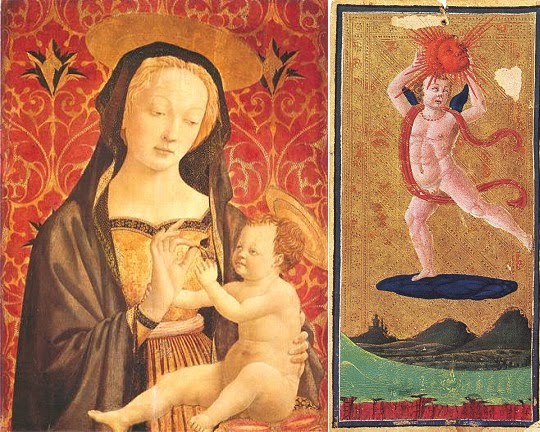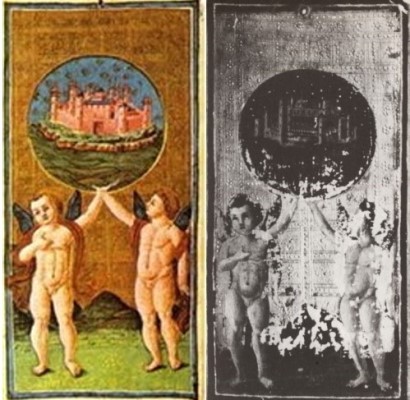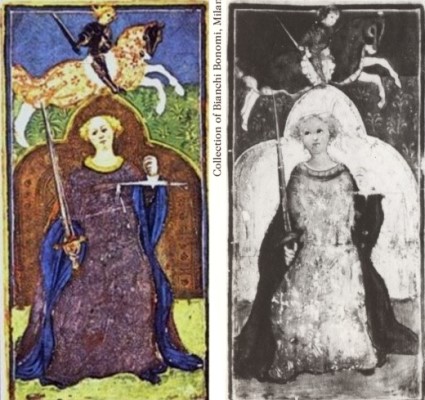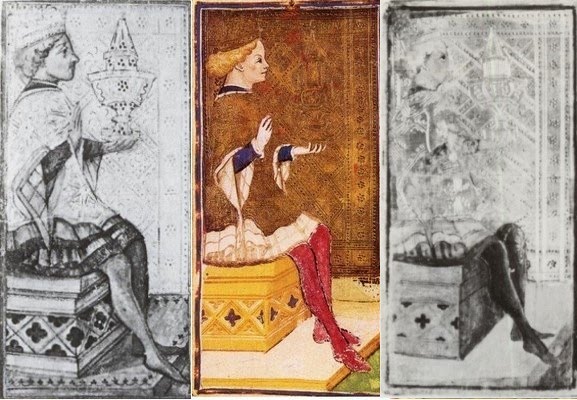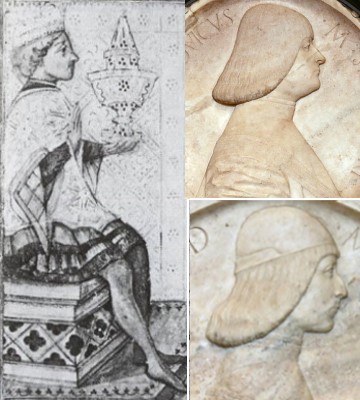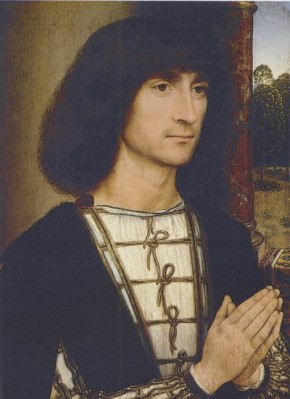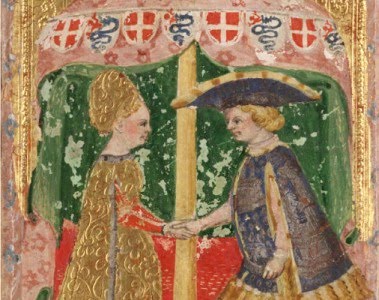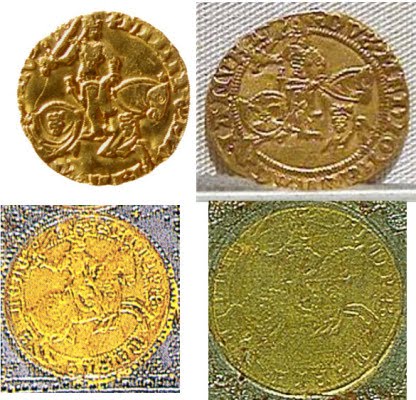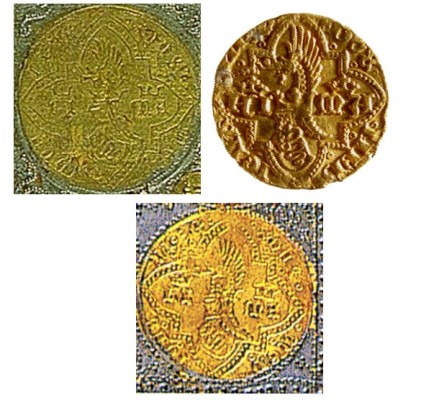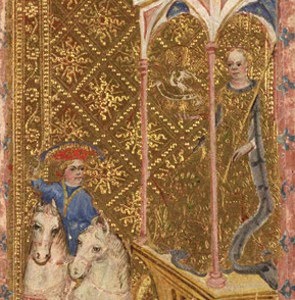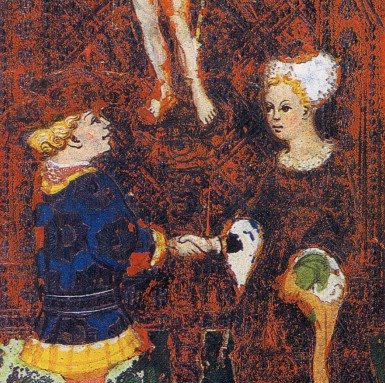Huck: I am finally replying to your post of a few days ago. I had to get together a lot of research on the history of the period 1450-1476, and it took me some time.
First, thanks for the links. I had guessed that the 13 cards in 1422 were extras, to go with the suit cards, but I appreciate the fuller account by Trionfi. I didn’t know about the other link. My Italian isn’t so good without digitalized text and Google’s automatic translator; but I will try to decipher that one paragraph.
The rest of this post is part of a response to your theory that the 6 cards of the PMB by the second artist are all additions, not replacements. In this post I am only going to give one set of considerations, having to do with the Sforza family’s needs and personalities, especially those of Bianca Maria, Francesco, and Galleazo Maria during the period 1450-1476. I will look at other considerations, e.g. visual details in the cards, in a later post.
First let me try to restate (my 2nd try) your theory for the original PMB. (This summary comes partly from your initial posts on the original thread for this topic, on the other forum, and partly from
http://trionfi.com/0/c/2209/.) You are saying that the PMB was created from scratch--not from the CY, anyway-by three 15 year olds, possibly aided by the suitor of one of them, at a New Year's celebration in Ferrara 1441. They designed 14 special cards and had them painted by an artist hired for the occasion in Ferrara and paid for by her suitor, Leonello d'Este. A peculiarity of the deck they designed was that it didn't have any virtue cards, because these 15 year olds weren't interested in virtue.
Bianca's father Philippo liked some of these cards but not others. He wanted a deck that blended three of his passions: cards, chess, and Petrarch. He wanted the pawns to be the 7 virtues plus Love, and the other chess pieces to be various important members of society, whom the virtues serve. Seven of Bianca's cards would work well in the first chess row: Angel of Judgment for the castle (rook), Death for one knight, Chariot for the other knight, Pope and Popess for the bishops, and Emperor and Empress for the king and queen. In this row, Philippo would only have to design one card, for the second castle. These same seven cards would serve for 3 of the 6 Petrarch triumphs: Chariot--a lady riding while her lover manages the horses--will serve for Chastity. Death is Death, and the Angel of Judgment is Eternity. Another of Bianca’s cards was Love, which would serve both as a triumph and as a virtue. Finally he could use her picture of a woman and her courting knight; it would be the virtue Justice and also the triumph of Time. The only triumph not accounted for was Fame.
Five of Bianca's ideas he couldn't use (even though two of them were standard symbols of Time, an old man and a wheel). The other rejected cards were an elegantly attired conjurer, a deranged man, and a man hanging from one foot. Philippo set about designing seven more cards, corresponding to the virtues and Fame; then he would have 16 in all, the same as the number of chess pieces. These cards were Faith, Hope, Charity, Fortitude, Temperance, Prudence, and Fame. (Sometimes Huck writes as though Prudence and Fame were the same card; but if so the deck is one card short.)
The result was the deck we know call the Cary-Yale, which Philippo gave to Bianca and Francesco as a wedding gift. But Bianca still liked the old idea. So when her husband grabbed Milan in 1450, she wanted a luxury deck based on the girls' original ideas. Francesco obliged with the original PMB, which is the PMB we have minus the 6 cards painted later.
Trionfi offers documentation for this theory: (a) 14 paintings of figures delivered at night (party time) to Bianca Maria Visconti, paid for in January, 1441, Ferrara; (b) a chess club at court in Milan, 1441; (c) Francesco asking his secretary to get him trionfi decks in 1450; (d) five 70 card decks paid for, with lots of gold leaf on them, 1457.
It seems to me that the 14 “figures,” presumably a gift from the man courting Bianca, Leonello d’Este, could have been 14 Ferrara-style proto-tarot subjects, which he might have preferred to those of Milan, or 14 of some other trionfi pattern, etc. Then in 1450 Francesco could well have been thinking of commissioning a luxury deck. What the cards were is the point at issue; they could have been something less luxurious and now lost. The 1457 cards could have been Ferrara-style cards, not Milan-style. There is no reason to think that all cities had the same decks.
If the story were meant as fiction I would say that it lacks plausibility. First, it is a bit of a stretch to suppose that two-thirds of the girls’ cards just happened to fit Filippo’s chess and Petrarch obsession. It is also a stretch to suppose that they would include Death and Judgment without the virtues, the criteria by which one is judged. Also, how is a woman with scales in her hand not Justice? Or did Philippo add that part? And what does such a woman have to do with Time? She is the primary figure on the card, and the knight is merely doing her bidding. It is again a stretch to say that the card, besides being Justice, is about the time it will take for him to win the lady. There is also the issue of the Prudence card. “Four cardinal virtues” is only one way virtues were classified then. There were “three moral virtues.” There is, to be sure, Prudence in Minchiate. But I find no trail of decks between it and the CY.
And there is a larger issue that I want to talk about mostly: the time of the deck’s actual creation, the shift from 1441 to 1450. Even assuming Bianca was indifferent to virtue in 1441, by 1450 she would not have been. She was not 15 any more: she was a 24 year old mother of three, and a duchess with much experience of the world already behind her (see Wikipedia article on her). The three children included a future Duke of Milan and a girl who would need to be married off eventually. More were on the way—8 in all, the last in 1458. They would all need training in virtue. That was what a humanist education was all about. Cards were an educational tool in this program. If the PMB at all reflects the Sforzas’ needs as a family, it would have had cards representing Fortitude and Temperance as well as Justice—the three primary Aristotelian moral virtues. I will document their concerns.
It is clear from Francesco’s correspondence that indoctrinating their children in virtue was very much on his and Bianca’s minds, starting with that of the heir-apparent, who must have already been displaying upsetting behavior. Lubkin (
A Renaissance Court p. 24) quotes a letter by the 8 year old Galeazzo, where he tells his father that he is acquiring “letters and [good] habits, and pursuing true and solid glory, so that I will not degenerate from your glorious and divine virtues, which have allowed you to such height of empire.” The boy also asked his father “not to let me lack horses, dogs, birds, or anything else that would please me.” This letter is too candid to reassure a father.
In July 1457, when Galeazzo was 13, his father sent him a letter. “Considering that now you are of an age to know good and evil,” Francesco chose “not to wait any longer to tell you the manners which we want you to observe, so that you may never for any time say you have not had your vices and bad habits admonished and repressed, and that you have never been given the order of life and customs and manners that you have to keep” (Lubkin p. 24f). He then gives his son 10 points of “manners” for Galeazzo to obey. Lubkin summarizes them as follows:
(1) “To be devoted to God”; (2) to be “reverent and obedient” to his mother grandmother, tutor, and “every other wise and virtuous person”; (3) “to be reverent and modest” at home or elsewhere and always to honor guests; (4) “to be honest and humane in speaking with everyone, according to their rank, quality and condition”; (5) “not to play with irons, stones or sticks” or to “persevere in anger and hatred”; (6) not to commit “any act of cruelty nor of arrogance” but to use “magnanimity, justice, and clemency”; (7) “not to be hungry for those things that are not worthy or necessary, and not to want all the things that are not worthy or necessary, and not to want all the things that you see and that come into your mind”; (8) neither to lie nor to encourage slanderers, “because the customs of the household which are not laudable bring infamy to the patron”; (9) to be moderate in eating and drinking; and (10) “because you delight in horses and have to use them, see that you never ride a horse with a hard mouth, nor one which has bad feet or which bucks.” (Lubkin p. 25)
This list covers the moral virtues in the CY well, virtues also present in the Michelino “virtues” suit. It does not mention Fortitude or Strength, but does talk about not being cruel or arrogant, dangers connected with the improper exercise of Strength. It also does not mention the dangers of Pleasure, specifically the vice of Lust; well, Francesco himself had numerous affairs. There is also no mention of specific theological virtues. Galeazzo did not have a problem going to church and other outward displays of piety. He went to church every morning, loved church music, and even was murdered in church.
Of course the boy’s behavior continued to be a disappointment. There was, for example, the incident in 1459 when Galeazzo refused to follow protocol and dismount while escorting Pope Pius II In 1460 Francesco admitted that his son “fears no one and does whatever enters his head” (both Lubkin p. 26 ). Well, they had 7 other children.
Virtuous conduct, or at least conduct that appeared virtuous, was also important for the family’s ability to maintain power, from 1450 on. Francesco had no legal claim to the Dukedom; a vote by some townsmen facing starvation was no legal argument. In fact, Sforza’s ambassadors’ main argument at home and abroad was “the
virtus and other qualities of Francesco Sforza himself. …Francesco Sforza is praised not only for his military prowess, his innumerable victories, etc., but also for his
integritas, iustitia, and
clementia, the qualities associated with the ideal ruler. He is in fact portrayed as a model of virtus and sapientia, who will, by the exercise of these qualities, bring peace and civil order to a divided society” (Gary Ianziti,
Humanistic Historiography under the Sforzas, p. 31). Ianziti describes an extensive propaganda campaign to keep the nobles and outside political powers from unseating him. It includes generosity to those who had opposed him but changed their minds; only those who represented a continued menace were imprisoned; the die-hard republican Decembrio was allowed a gracious exile.
I would not be surprised if the holes we see at the top in the CY, PMB, and other PMB-style cards were not made then, in this crisis period 1450-1464 (when he finally got an alliance with Louis XII of France, per Ianziti p. 22). To display the decks on state occasions would have been good propaganda. They would show the continuity between the old and the new, reminding their viewers that the Visconti line did not die out, but continued on the maternal side, and with people who valued the traditional virtues. They could see one old deck, celebrating Visconti’s 1428 marriage (or so some might assume, given the Love card’s banners), and at some point another similar deck celebrating its repetition in the current generation but with Visconti and Sforza emblems. (I am not saying that the CY was created in 1428. I am talking about appearances. For all the evidence I have seen, the CY may have been created in 1452, simulating the world of 1428. Francesco actually stooped to forgery once, according to Ianzita, p. 31, producing a document attesting to be Filippo’s “donation” granting him the dukeship.)
I think I can also explain why 2-3 of the cards would have been replaced rather than kept like the rest. For one card, Fortitude, the reason is clear enough. Francesco would not have approved such an image as a man looking rather like him clubbing a poor lion to death or submission. It is the very vice he cautioned his son about. True, he was the most successful military man of his generation; but after 1450 all he wanted was to keep the Duchy running as before. That was his appeal and his hold on power (one that his sons unfortunately did not follow, dreaming of higher things). He was threatened on all sides by attack, for being a usurper. In reply his was the image of peace; to secure it, he organized “the first great modern peace conference (Lubkin p. 19), in 1455. But even after that, “the period of 1457 to 1463 might be described as one of the most critical” (Ianziti p. 67). In this context, a card such as the PMB’s clubbed lion would have been an insult and a provocation to those not part of the alliance. The original PMB card, in my opinion, was similar to the CY’s: a courageous but physically weak female winning the cooperation of a powerful but grateful lion (like that of St. Jerome); the lion would be the nobility of Lombardy and the city-states allied with Milan, the woman Bianca Maria Sforza.
But once Francesco was dead, his son Galeazzo Maria could well have commissioned such a card (Ross mentions this possibility,
http://www.angelfire.com/space/tarot/hercule.html). Galeazzo was the one who initiated plans for a mammoth equestrian memorial to Francesco after his death (Izansiti p. 142). He had a “cruel streak,” says Wikipedia, with graphic details. At one point he bought a tame lion for his little son (in Lubkin). I hesitate to think what kind of show Galeazzo might have put on in making it do tricks. He ruled by fear and feared everyone (Lubkin). It would not have been beyond him to portray his father in the same light, great physical force overcoming great physical force.
As for Temperance, I think that one, too, was a remake. The CY had a Temperance card. I see no reason why Sforza decks in the 1450’s would not have continued with it; the virtue is mentioned in Francesco’s rules for his son. The subject was popular in other cities: both the d’Este and the Charles VI have it. As to why it would have been replaced, I suspect that Galeazzo wanted to change the face on the card, so he could tell one or more women that he was honoring her. As Huck says, we see the same face on two of the new cards, Star and Moon. (I will say more about that face in another post.)
Then there is the card I call Glory, otherwise known as World and Fame. Looking back at Francesco’s correspondence already quoted, I can indeed imagine the card’s being dropped until something better could be put in its place. Galeazzo had worldly fame on the brain (at the expense of prudence), and Francesco didn’t like it. The CY card did not stand clearly for “eternal fame” as opposed to “worldly fame,” achieved by reckless means, if Trionfi’s identification of the little man in the boat is accurate. On the other hand, some glorification of Niccolo Piccinino (the man in the boat) continued to be worthwhile, not to mention of Francesco, the knight on the bank. Nicollo was already dead, but in the 1450’s Giocamo Piccinino led the main opposition to Francesco within Lombardy, the so-called Braccian party (Ianziti p. 26). So Francesco and Bianca went out of their way to grant the family status and recognition—in 1462 they even married one of his illegitimate daughters to Niccolo Piccinino’s son Jacopo. So maybe the original PMB card was like the CY’s. Alternatively it could well have been omitted, until after the Piccininos ceased to be a threat. Or it had some other design deemed unsuitable later.
By1465 Giacomo and Jacopo Piccinino were both dead, Jacopo at least by murder in Naples (Lubkin p. 82). Niccolo’s name could now safely be blackened. Ianziti shows how in the 1480’s, for a new edition, the official Sforza history of the period, Simonetta’s
Commentaries, was rewritten to turn Piccinino’s adventures against him (p. 228). He certainly no longer needed to be on the card. The second artist’s PMB “World” fit the times.
The “three luminaries” are new cards, two featuring the lady of Temperance and one with a child, although in a sense they are also remakes of the three theological virtues. I will discuss them in more detail, including the people on these cards, in another post.
My theory, such as it is, puts the PMB in the context of the Sforza family of the 1450’s through early 1470’s: the original PMB, perhaps in stages, was done during the time Bianca and Francesco were raising their family and achieving stability for the regime, 1450-1466; developing directly out of the CY, it had anywhere between 13 and 17 cards. Then Galeazzo redidt at least two cards (Fortitude and Temperance) and introduced up to 4 new ones.
I so far haven’t given any date for when the original PMB was done, or its stages, or for that matter the CY (other than 1441-1465 for the original PMB, 1466 or later for the additions, and after 1428, but before the original PMB, for the CY). To do so would require examining specific cards in the context of known artwork, events, and writings of the time and earlier. I will get to that in a later post. We also have to bear in mind that these particular cards were likely not the only ones in existence; there were other, cheaper decks used for actual play, and some of the evolution of the deck might have taken place there. And there are other PMB-style luxury decks to consider. The PMB is the tip of the iceberg. In this post I have only been considering the needs and personalities of the Sforza family 1450-1476. They are incompatible with Trionfi’s theory, at least concerning the original PMB.
I should say something about how the Popess and the Hanged Man might have come about, in a way that does not depend on chess analogies. Since they are unorthodox cards they may have been added to the original deck, painted by the same artist at a different time. The Sforzas had Boccaccio’s
Of Famous Women in their library (Franklin, Boccaccio’s Heroines, p. 12, at Google Books). It includes an account of the life of the legendary Pope Joan. In Boccaccio’s account, God only gets angry when she becomes Pope. Then God “abandoned to her own devices this person who boldly persisted in doing what should not have been done” (illam indebita audentem nec sinentem suis in minibus liquit
Famous Women pp. 438-439, ed. and trans. Brown), perhaps implying that God helped her before that. There were many manuscripts, including one in the Visconti-Sforza library. The Boccacci illustration of Pope Joan posted by Ross shows some similarity to the card (
http://www.angelfire.com/space/tarot/papessa.html). Besides Joan, there was Sister Manfreda, the Visconti ancestor, the “Popess” burned at the stake in c. 1300 Venice. The resemblance of the PMB Popess to Giotto’s Faith or Justice, c. 1305 Padua, may in part have been to help us recall that other nearby time and place (for the PMB Popess, see previous citation to Ross); for Giotto, see
http://www.christusrex.org/www1/giotto/virtues.html). Like these two models, and probably some abbesses she knew, Bianca was a strong woman, an able administrator, diplomat, and perhaps even military leader (see Wikipedia). She gave her daughters the finest education available.
As for the Hanged Man, he is another exercise in ambiguity, appropriate as the children got older: Don’t take appearances at face value, and temporary humiliation at the hands of others is not always a bad thing in the larger picture: look at grandfather Muzio. As usual, Galeazzo missed the point; in 1466 he posted images on the city gate of a friend of his who offended him “in the usual way,” meaning upside down (Lubkin p. 32).
Before I write much more, Huck, I have a favor to ask. In an earlier post on ATF, Ross mentioned a recent article by Dummett, in which in the last two-thirds of a page he maintains that both artists of the PMB did their work in 1462-1463. Ross forwarded your summary, from Trionfi; but I would really like to see his own words, just that part of the article. This is not to doubt your summary; it’s just that in general I like to see primary rather than secondary sources, when available. (And well, when someone who isn’t a native speaker of one language summarizes something written in another language, maybe I do wonder if the whole meaning was represented exactly.) There may be copyright considerations here. If so, then just quote the part about 1462-1463 as the date. Or suggest how I can get the article myself. Thanks.
